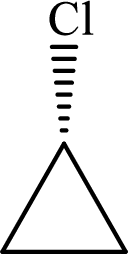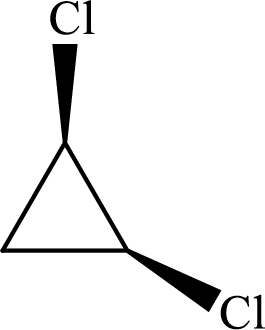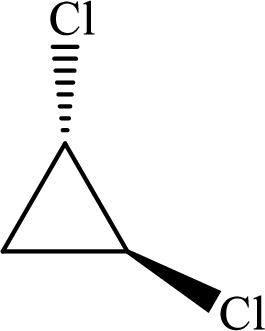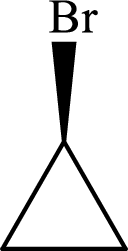
GENERAL,ORGANIC,+BIOCHEMISTRY-ALEKS 360
10th Edition
ISBN: 9781260994148
Author: Denniston
Publisher: MCGRAW-HILL HIGHER EDUCATION
expand_more
expand_more
format_list_bulleted
Concept explainers
Question
Chapter 10, Problem 10.85QP
(a)
Interpretation Introduction
Interpretation:
Given cycloalkane has to be named using

Concept Introduction:
IUPAC rules for naming cycloalkanes:
A common nomenclature of naming organic compounds has been developed by IUPAC. By usage of this nomenclature or rules, memorizing of names of organic compounds is not necessary.
- The number of carbon atoms present in the ring is counted and the name of the
alkane that has the same number of carbon atoms is given by adding prefix “cyclo-” to the alkane name. - If the ring is substituted, then the names of the group or atoms have to be placed before the name of cycloalkane. If only one substituent is present, then number is not required.
- If the ring contains more than one substituent, then the numbers has to be used in a way that it gives the lowest position for the substituents.
(b)
Interpretation Introduction
Interpretation:
Given cycloalkane has to be named using IUPAC nomenclature.

Concept Introduction:
Refer part (a).
(c)
Interpretation Introduction
Interpretation:
Given cycloalkane has to be named using IUPAC nomenclature.

Concept Introduction:
Refer part (a).
(d)
Interpretation Introduction
Interpretation:
Given cycloalkane has to be named using IUPAC nomenclature.

Concept Introduction:
Refer part (a).
Expert Solution & Answer
Want to see the full answer?
Check out a sample textbook solution
Students have asked these similar questions
3. Arrange the different acids in Exercise B # 2 from the strongest (1) to the weakest acid
(10).
1.
2.
(strongest)
3.
4.
5.
6.
7.
8.
9.
10
10.
(weakest)
Name
Section
Score
Date
EXERCISE B
pH, pOH, pка, AND PKD CALCULATIONS
1. Complete the following table.
Solution
[H+]
[OH-]
PH
РОН
Nature of Solution
A
2 x 10-8 M
B
1 x 10-7 M
C
D
12.3
6.8
2. The following table contains the names, formulas, ka or pka for some common acids. Fill
in the blanks in the table. (17 Points)
Acid Name
Formula
Dissociation reaction
Ka
pka
Phosphoric acid
H₂PO₁
H3PO4
H++ H₂PO
7.08 x 10-3
Dihydrogen
H₂PO
H₂PO
H+ HPO
6.31 x 10-6
phosphate
Hydrogen
HPO₁
12.4
phosphate
Carbonic acid
H2CO3
Hydrogen
HCO
6.35
10.3
carbonate or
bicarbonate
Acetic acid
CH,COOH
4.76
Lactic acid
CH₂CHOH-
COOH
1.38 x 10
Ammonium
NH
5.63 x 10-10
Phenol
CH₂OH
1 x 10-10
Protonated form
CH3NH3*
3.16 x 10-11
of methylamine
Indicate whether it is true that Co(III) complexes are very stable.
Chapter 10 Solutions
GENERAL,ORGANIC,+BIOCHEMISTRY-ALEKS 360
Ch. 10.1 - Prob. 10.1QCh. 10.1 - Prob. 10.2QCh. 10.2 - Prob. 10.3QCh. 10.2 - Prob. 10.4QCh. 10.3 - Prob. 10.1PPCh. 10.3 - Prob. 10.5QCh. 10.3 - Prob. 10.6QCh. 10.3 - Prob. 10.2PPCh. 10.3 - Prob. 10.3PPCh. 10.3 - Heptane is a very poor fuel and is given a zero on...
Ch. 10.4 - Name each of the following cycloalkanes using...Ch. 10.4 - Prob. 10.6PPCh. 10.4 - Prob. 10.7PPCh. 10.6 - Write a balanced equation for the complete...Ch. 10.6 - Write a balanced equation for each of the...Ch. 10.6 - Prob. 10.8QCh. 10 - Prob. 10.9QPCh. 10 - Prob. 10.10QPCh. 10 - Prob. 10.12QPCh. 10 - Prob. 10.13QPCh. 10 - Prob. 10.14QPCh. 10 - Prob. 10.15QPCh. 10 - Prob. 10.16QPCh. 10 - Prob. 10.17QPCh. 10 - Prob. 10.18QPCh. 10 - Prob. 10.19QPCh. 10 - Prob. 10.20QPCh. 10 - Prob. 10.21QPCh. 10 - Describe the major differences between ionic and...Ch. 10 - For centuries, fishermen have used shark liver oil...Ch. 10 - Prob. 10.24QPCh. 10 - Prob. 10.25QPCh. 10 - Prob. 10.26QPCh. 10 - Prob. 10.27QPCh. 10 - Prob. 10.28QPCh. 10 - Prob. 10.29QPCh. 10 - Prob. 10.30QPCh. 10 - Prob. 10.31QPCh. 10 - Prob. 10.32QPCh. 10 - Prob. 10.33QPCh. 10 - Prob. 10.34QPCh. 10 - Prob. 10.35QPCh. 10 - Prob. 10.36QPCh. 10 - Prob. 10.37QPCh. 10 - Prob. 10.38QPCh. 10 - Prob. 10.39QPCh. 10 - Prob. 10.40QPCh. 10 - Prob. 10.41QPCh. 10 - Prob. 10.42QPCh. 10 - Prob. 10.43QPCh. 10 - Prob. 10.44QPCh. 10 - Prob. 10.45QPCh. 10 - Prob. 10.46QPCh. 10 - Prob. 10.47QPCh. 10 - Prob. 10.48QPCh. 10 - Prob. 10.49QPCh. 10 - Prob. 10.50QPCh. 10 - Prob. 10.51QPCh. 10 - Prob. 10.52QPCh. 10 - Prob. 10.53QPCh. 10 - Prob. 10.54QPCh. 10 - Prob. 10.55QPCh. 10 - Prob. 10.56QPCh. 10 - Prob. 10.57QPCh. 10 - Prob. 10.58QPCh. 10 - Prob. 10.59QPCh. 10 - Prob. 10.60QPCh. 10 - Prob. 10.61QPCh. 10 - Prob. 10.62QPCh. 10 - Prob. 10.63QPCh. 10 - Prob. 10.64QPCh. 10 - Prob. 10.65QPCh. 10 - Prob. 10.66QPCh. 10 - Prob. 10.67QPCh. 10 - Prob. 10.68QPCh. 10 - Prob. 10.69QPCh. 10 - Prob. 10.70QPCh. 10 - Prob. 10.71QPCh. 10 - Prob. 10.72QPCh. 10 - Prob. 10.73QPCh. 10 - Prob. 10.74QPCh. 10 - Prob. 10.75QPCh. 10 - Prob. 10.76QPCh. 10 - Are the following names correct or incorrect? If...Ch. 10 - In your own words, describe the steps used to name...Ch. 10 - Draw the structures of the following compounds....Ch. 10 - Prob. 10.80QPCh. 10 - Prob. 10.81QPCh. 10 - Prob. 10.82QPCh. 10 - Prob. 10.83QPCh. 10 - Prob. 10.84QPCh. 10 - Prob. 10.85QPCh. 10 - Prob. 10.86QPCh. 10 - Prob. 10.87QPCh. 10 - Draw each of the following...Ch. 10 - Prob. 10.89QPCh. 10 - Prob. 10.90QPCh. 10 - Which of the following names are correct and which...Ch. 10 - Which of the following names are correct and which...Ch. 10 - Prob. 10.93QPCh. 10 - Prob. 10.94QPCh. 10 - Prob. 10.95QPCh. 10 - Prob. 10.96QPCh. 10 - What are conformational isomers?
Ch. 10 - Prob. 10.98QPCh. 10 - Make a model of cyclohexane and compare the boat...Ch. 10 - Prob. 10.100QPCh. 10 - Prob. 10.101QPCh. 10 - Prob. 10.102QPCh. 10 - Prob. 10.103QPCh. 10 - Prob. 10.104QPCh. 10 - Prob. 10.105QPCh. 10 - Prob. 10.106QPCh. 10 - Prob. 10.107QPCh. 10 - Prob. 10.108QPCh. 10 - Prob. 10.109QPCh. 10 - Prob. 10.110QPCh. 10 - Prob. 10.111QPCh. 10 - Prob. 10.112QPCh. 10 - Prob. 1MCPCh. 10 - Prob. 2MCPCh. 10 - Prob. 3MCPCh. 10 - Indicate which of the following are true of...Ch. 10 - Prob. 7MCPCh. 10 - Prob. 8MCPCh. 10 - Prob. 9MCPCh. 10 - Prob. 10MCP
Knowledge Booster
Learn more about
Need a deep-dive on the concept behind this application? Look no further. Learn more about this topic, chemistry and related others by exploring similar questions and additional content below.Similar questions
- MnO2 acts as an oxidant in the chlorine synthesis reaction.arrow_forwardIn Potassium mu-dihydroxydicobaltate (III) tetraoxalate K4[Co2(C2O4)4(OH)2], indicate whether the OH ligand type is bidentate.arrow_forwardImagine an electrochemical cell based on these two half reactions with electrolyte concentrations as given below: Oxidation: Pb(s) → Pb2+(aq, 0.10 M) + 2 e– Reduction: MnO4–(aq, 1.50 M) + 4 H+(aq, 2.0 M) + 3 e– → MnO2(s) + 2 H2O(l) Calculate Ecell (assuming temperature is standard 25 °C).arrow_forward
- : ☐ + Draw the Fischer projection of the most common naturally-occurring form of aspartate, with the acid group at the top and the side chain at the bottom. Important: be sure your structure shows the molecule as it would exist at physiological pH. Click and drag to start drawing a structure. ✓arrow_forwardFor a silver-silver chloride electrode, the following potentials are observed: E°cell = 0.222 V and E(saturated KCl) = 0.197 V Use this information to find the [Cl–] (technically it’s the activity of Cl– that’s relevant here, but we’ll just call it “concentration” for simplicity) in saturated KCl.arrow_forwardA concentration cell consists of two Sn/Sn2+ half-cells. The cell has a potential of 0.10 V at 25 °C. What is the ratio of [Sn2+] (i.e., [Sn2+left-half] / [Sn2+right-half])?arrow_forward
- Electrochemical cell potentials can be used to determine equilibrium constants that would be otherwise difficult to determine because concentrations are small. What is Κ for the following balanced reaction if E˚ = +0.0218 V? 3 Zn(s) + 2 Cr3+(aq) → 3 Zn2+(aq) + Cr(s) E˚ = +0.0218 Varrow_forwardConsider the following half-reactions: Hg2+(aq) + 2e– → Hg(l) E°red = +0.854 V Cu2+(aq) + 2e– → Cu(s)E°red = +0.337 V Ni2+(aq) + 2e– → Ni(s) E°red = -0.250 V Fe2+(aq) + 2e– → Fe(s) E°red = -0.440 V Zn2+(aq) + 2e– → Zn(s) E°red = -0.763 V What is the best oxidizing agent shown above (i.e., the substance that is most likely to be reduced)?arrow_forwardCalculate the equilibrium constant, K, for MnO2(s) + 4 H+(aq) + Zn(s) → Mn2+(aq) + 2 H2O(l) + Zn2+(aq)arrow_forward
- In the drawing area below, draw the condensed structures of formic acid and ethyl formate. You can draw the two molecules in any arrangement you like, so long as they don't touch. Click anywhere to draw the first atom of your structure. A C narrow_forwardWrite the complete common (not IUPAC) name of each molecule below. Note: if a molecule is one of a pair of enantiomers, be sure you start its name with D- or L- so we know which enantiomer it is. molecule Ο C=O common name (not the IUPAC name) H ☐ H3N CH₂OH 0- C=O H NH3 CH₂SH H3N ☐ ☐ X Garrow_forward(Part A) Provide structures of the FGI products and missing reagents (dashed box) 1 eq Na* H* H -H B1 B4 R1 H2 (gas) Lindlar's catalyst A1 Br2 MeOH H2 (gas) Lindlar's catalyst MeO. OMe C6H1402 B2 B3 A1 Product carbons' origins Draw a box around product C's that came from A1. Draw a dashed box around product C's that came from B1.arrow_forward
arrow_back_ios
SEE MORE QUESTIONS
arrow_forward_ios
Recommended textbooks for you
 ChemistryChemistryISBN:9781305957404Author:Steven S. Zumdahl, Susan A. Zumdahl, Donald J. DeCostePublisher:Cengage Learning
ChemistryChemistryISBN:9781305957404Author:Steven S. Zumdahl, Susan A. Zumdahl, Donald J. DeCostePublisher:Cengage Learning ChemistryChemistryISBN:9781259911156Author:Raymond Chang Dr., Jason Overby ProfessorPublisher:McGraw-Hill Education
ChemistryChemistryISBN:9781259911156Author:Raymond Chang Dr., Jason Overby ProfessorPublisher:McGraw-Hill Education Principles of Instrumental AnalysisChemistryISBN:9781305577213Author:Douglas A. Skoog, F. James Holler, Stanley R. CrouchPublisher:Cengage Learning
Principles of Instrumental AnalysisChemistryISBN:9781305577213Author:Douglas A. Skoog, F. James Holler, Stanley R. CrouchPublisher:Cengage Learning Organic ChemistryChemistryISBN:9780078021558Author:Janice Gorzynski Smith Dr.Publisher:McGraw-Hill Education
Organic ChemistryChemistryISBN:9780078021558Author:Janice Gorzynski Smith Dr.Publisher:McGraw-Hill Education Chemistry: Principles and ReactionsChemistryISBN:9781305079373Author:William L. Masterton, Cecile N. HurleyPublisher:Cengage Learning
Chemistry: Principles and ReactionsChemistryISBN:9781305079373Author:William L. Masterton, Cecile N. HurleyPublisher:Cengage Learning Elementary Principles of Chemical Processes, Bind...ChemistryISBN:9781118431221Author:Richard M. Felder, Ronald W. Rousseau, Lisa G. BullardPublisher:WILEY
Elementary Principles of Chemical Processes, Bind...ChemistryISBN:9781118431221Author:Richard M. Felder, Ronald W. Rousseau, Lisa G. BullardPublisher:WILEY

Chemistry
Chemistry
ISBN:9781305957404
Author:Steven S. Zumdahl, Susan A. Zumdahl, Donald J. DeCoste
Publisher:Cengage Learning

Chemistry
Chemistry
ISBN:9781259911156
Author:Raymond Chang Dr., Jason Overby Professor
Publisher:McGraw-Hill Education

Principles of Instrumental Analysis
Chemistry
ISBN:9781305577213
Author:Douglas A. Skoog, F. James Holler, Stanley R. Crouch
Publisher:Cengage Learning

Organic Chemistry
Chemistry
ISBN:9780078021558
Author:Janice Gorzynski Smith Dr.
Publisher:McGraw-Hill Education

Chemistry: Principles and Reactions
Chemistry
ISBN:9781305079373
Author:William L. Masterton, Cecile N. Hurley
Publisher:Cengage Learning

Elementary Principles of Chemical Processes, Bind...
Chemistry
ISBN:9781118431221
Author:Richard M. Felder, Ronald W. Rousseau, Lisa G. Bullard
Publisher:WILEY
Chapter 4 Alkanes and Cycloalkanes Lesson 2; Author: Linda Hanson;https://www.youtube.com/watch?v=AL_CM_Btef4;License: Standard YouTube License, CC-BY
Chapter 4 Alkanes and Cycloalkanes Lesson 1; Author: Linda Hanson;https://www.youtube.com/watch?v=PPIa6EHJMJw;License: Standard Youtube License